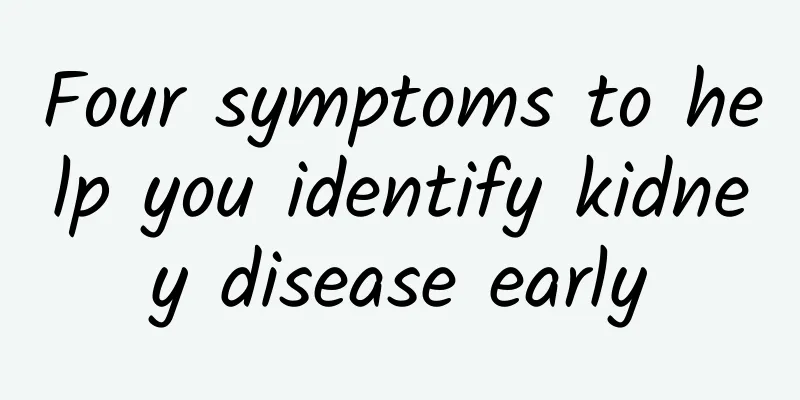Four symptoms to help you identify kidney disease early

|
Author: Zheng Xixi Peking Union Medical College Hospital Reviewer: Chen Gang, deputy chief physician, Peking Union Medical College Hospital 1. Understanding our kidneys The kidneys are important organs in the human body, located on both sides of the waist in the back. Each person usually has 2 kidneys. The shape is similar to a bean, and each kidney is about the size of a fist. The kidneys are made up of many small units, called nephrons, and each kidney has about 1 million nephrons. Each nephron contains 2 main parts, namely the glomerulus and the renal tubule. The glomerulus is a tiny capillary ball that is responsible for filtering waste and excess water from the blood. The renal tubule further processes the filtered substances, absorbs the nutrients and water needed by the body, and excretes the unnecessary parts to form urine. Figure 1 Copyright image, no permission to reprint The kidneys play a key role in maintaining good health. 1. Filtering blood: The kidneys filter about 200L of blood every day. The blood in the whole body is filtered in the kidneys 60 times a day. Among them, the waste products and excess water produced by metabolism will be converted into urine and excreted from the body. 2. Regulating water and electrolyte balance: The kidneys maintain the body's internal environment stability and balance by regulating the levels of water and minerals (such as sodium, potassium, calcium, and phosphorus) in the body. 3. Regulates blood pressure: The kidneys help control blood pressure by regulating salt and water in the body. 4. Production of red blood cells: The kidneys secrete a hormone called erythropoietin, which stimulates the bone marrow to produce red blood cells and plays an important role in red blood cell production. 5. Maintain bone health: The kidneys help activate vitamin D, promote calcium absorption, and maintain strong bones. Figure 2 Copyright image, no permission to reprint Although the kidneys are not large in size, they consume about 10% of the body's energy every day, which shows that the work of the kidneys is very important and is a "high-energy consumption" organ. The kidneys are not only a "waste and sewage treatment plant", but also the center for maintaining the balance of the body's internal environment. Therefore, the kidneys are prone to "fatigue". If the kidneys, which are working continuously every minute and every second, are additionally damaged, such as taking kidney-damaging drugs, high blood pressure, diabetes, high uric acid, obesity and other metabolic problems, as well as kidney diseases such as glomerulonephritis, they may become sick or even "go on strike". Some kidney diseases are more rapid in onset and are called acute kidney injury, while some kidney diseases are caused by long-term overwork and are called chronic kidney disease. 2. 1 in 10 people suffer from chronic kidney disease Chronic kidney disease is not far from our lives. Globally, one in every 10 people suffers from chronic kidney disease. As a country with a large population, my country is also one of the countries with a heavy burden of kidney disease. Recent statistics show that the total number of chronic kidney disease patients in my country is about 120 million, and with the popularization of disease screening, the aging of the population and the increase in metabolic diseases year by year, the prevalence of chronic kidney disease is still rising. Chronic kidney disease is not like a cold or fever, which can be cured and return to normal. Once kidney function is damaged, the damage is likely to be irreversible. When part of the kidney is damaged, the remaining healthy kidney needs to work twice as hard to "compensate". Over time, the remaining kidney will be damaged more quickly, which is why chronic kidney disease progresses slowly in the early stages, but in the later stages, the condition will accelerate. Eventually, when the kidneys stop working completely, patients will have to rely on dialysis or kidney transplantation to maintain their lives. It is estimated that by 2025, the number of people on dialysis in my country will reach 1.34 million, which has placed a huge burden on patients, their families and the medical system. Figure 3 Copyright image, no permission to reprint 3. Four major warning symptoms to help you detect kidney disease early The kidney is an organ that works very hard. There are often no obvious symptoms in the early stages of the disease, so early kidney disease is easily ignored. When symptoms appear, the disease has often developed to a serious stage. Many people only realize the seriousness of the problem when their kidneys have been severely damaged. Therefore, regular physical examinations and attention to small changes in the body are key to early detection of kidney disease, especially for people with high blood pressure, diabetes or a family history of kidney disease. If you find yourself with any symptoms suspected of kidney disease, even if you are not sure, you should go to the hospital for examination. In the early stages of kidney disease, the body will send out some warning signals, which we call "alarm symptoms." Understanding and paying attention to these signals, early detection and early treatment can effectively delay the progression of the disease and protect kidney function. So, what are the "alarm symptoms" in the eyes of nephrologists? Let the doctors at Peking Union Medical College tell you how to detect kidney disease early through these four symptoms. Signal 1: Changes in urine The kidneys are the organs that produce urine. If there is a problem with the kidneys, the first thing to be affected is the change in urine. 1. Changes in urine color: The most common change is red urine color. Some patients' urine color is like strong tea or even cola; some patients' urine color turns bright red. This is different from the yellow urine color caused by drinking less water and concentrated urine. 2. Increased foam in urine: Another common symptom of kidney disease is increased foam in urine. Patients may find that the foam in urine is similar to the foam produced when washing clothes or the foam of detergent used when washing dishes, and these foams do not dissipate for a long time. This phenomenon is usually due to increased protein content in urine. Under normal circumstances, the kidneys will ensure that the protein in the body is not excreted from the urine. When the kidneys are damaged, they cannot effectively retain protein, causing protein to be contained in the urine, resulting in proteinuria. If you experience red urine and increased foam in the urine, you must go to the hospital for a urine test in time. If the urine test results show abnormalities, you should be transferred to a specialist as soon as possible. Figure 4 Copyright image, no permission to reprint 3. Changes in urine volume If there is a significant change in urine volume, it can also be a sign of kidney disease. (1) Decreased urine volume: When the kidneys cannot filter fluid effectively, urine volume may decrease significantly. Sometimes, the patient's daily urine volume may be less than 400 ml, which is called "oliguria". In severe cases, "anuria" may occur, that is, the daily urine volume is less than 150 ml, indicating that the kidneys have been severely damaged. (2) Increased urine volume: In some cases, the kidneys may lose the ability to concentrate urine, causing the patient to excrete large amounts of dilute urine. This usually occurs in the early stages of kidney disease or when kidney function deteriorates further. (3) Increased nocturia: Some patients with kidney disease may find that they have to get up more often at night, which may be an early sign that the kidneys cannot effectively concentrate urine. If you get up 3 to 4 times at night, you should also see a doctor to see if you have kidney disease. Signal 2: Edema The kidneys are drainage organs that maintain the body's water and salt balance. When there is a problem with kidney function, the body cannot excrete excess fluid and salt normally, which will cause edema. Edema caused by kidney disease usually appears in areas with loose tissue, including the eyelids, ankles, and insteps. This type of edema can usually be seen as a pit when pressed. Ankles, legs, and feet are common areas of edema, especially after standing or walking for a period of time. Edema in the eyelid area is usually more obvious in the morning. Some patients with edema will feel their fingers are tight and unable to make a fist, and rings and bracelets are difficult to take off. If such edema occurs, you should seek medical attention in time. Figure 5 Copyright image, no permission to reprint Signal 3: Sudden changes in blood pressure The kidneys not only regulate water and salt balance, but also play a key role in regulating blood pressure. When kidney function is impaired, these regulatory mechanisms fail, leading to increased blood pressure. High blood pressure is not only a common symptom of kidney disease, but it also further damages kidney function, forming a vicious cycle. Continuous high blood pressure accelerates kidney damage and worsens the condition. Therefore, controlling blood pressure is particularly important for patients with kidney disease. If a person who usually has normal blood pressure suddenly experiences high blood pressure, or if a person with well-controlled hypertension suddenly experiences poor blood pressure control, especially when accompanied by dizziness, headache, or blurred vision, this is likely due to kidney disease causing uncontrolled blood pressure. In addition to kidney disease, blood pressure fluctuations are warning signs of many serious diseases, such as heart disease, cerebrovascular disease, etc. Therefore, the elderly, patients with hypertension and other people at risk of kidney disease should measure their blood pressure regularly and seek medical attention as soon as possible if any problems occur. Figure 6 Copyrighted images are not authorized for reproduction Signal 4: Fatigue and nausea Although nausea and fatigue are not specific symptoms of kidney disease, they are signs of worsening kidney disease in many patients. They are usually related to the gradual deterioration of kidney function and the accumulation of toxins in the body. 1. Fatigue: Fatigue or tiredness is one of the early symptoms of chronic kidney disease. As kidney function declines, the kidneys cannot effectively remove waste and toxins from the blood. These harmful substances accumulate in the body, interfering with the normal functioning of the body and causing general weakness and fatigue. In addition, the kidneys are the organs that produce the hematopoietic hormone erythropoietin. When kidney function is impaired, not enough erythropoietin can be produced, leading to anemia, which further aggravates fatigue. 2. Nausea: Nausea is usually caused by the kidneys’ inability to completely excrete metabolic waste, which leads to the accumulation of toxins in the body. When toxins accumulate to a certain extent, uremia will form, which is a pathological state that occurs when kidney function is severely impaired. These accumulated toxins can interfere with the normal functioning of the digestive system, leading to a series of digestive symptoms such as lack of appetite, nausea and vomiting. Patients may feel a strange taste in their mouths, especially in the morning, and may experience symptoms of nausea and dry heaving. These symptoms are often more obvious in the middle and late stages of chronic kidney disease. If you experience obvious nausea and fatigue, for example, a significant decrease in food intake to less than 1/3 of the normal amount, a special aversion to meat, and frequent nausea and vomiting, necessary examinations should be conducted to rule out the presence of kidney disease. Early management and control of chronic kidney disease is crucial to slowing the progression of the disease. Figure 7 Copyright image is not authorized for reproduction 4. If you suspect kidney disease, seek medical attention promptly and avoid taking random medications If you suspect that you or a family member has chronic kidney disease, the most important thing is to seek medical attention promptly and never take medication at will. Because the kidneys are important organs for drug metabolism, most drugs need to be broken down and excreted through the kidneys. If kidney function is already impaired, taking medication at will may increase the burden on the kidneys and may even worsen kidney disease. In particular, drugs with unknown ingredients, supplements, analgesics, cold medicines containing antipyretic ingredients, and antibiotics are all triggers that lead to worsening kidney disease. Finally, I hope everyone pays attention to a healthy lifestyle, has regular physical examinations, and checks blood pressure, urine routine, and kidney function, so as to detect signs of kidney problems early. Keep your kidneys in the best condition and let them work healthily for us for a lifetime. Figure 8 Copyright image, no permission to reprint |
<<: Take good care of your oral health before pregnancy to ensure a perfect pregnancy
>>: Why do I keep coughing after catching a cold?
Recommend
How to train abdominal muscles most effectively for girls
How should girls practice this abdominal muscle t...
When is the ovulation period for girls?
In many contemporary female friends' topics, ...
How long does the HPV vaccine last?
Cervical cancer harms the health of many women. I...
What to do if you have a cold and sneeze during pregnancy
Pregnant women should pay attention to the fact t...
What are the signs and reactions of pregnancy?
During pregnancy and when you can't get pregn...
How to relieve the pain of dysmenorrhea
Many women always have dysmenorrhea. Every time t...
Is it possible to be pregnant after 43 days of amenorrhea?
Now, sex education is still not fully open, I thi...
What are the dangers of running during menstruation?
Girls must pay attention to nourishing themselves...
21 people died in Gansu Baiyin Marathon. Why did extreme weather lead to hypothermia? How to save yourself?
The mountain marathon held in Baiyin, Gansu Provi...
Is early abortion dangerous?
In today's society, everyone's ideas are ...
What are the specific symptoms of ectopic pregnancy in early pregnancy
Ectopic pregnancy mainly refers to the phenomenon...
What should pregnant women do if they have candidal vaginitis?
Many pregnant women worry about inflammatory dise...
What causes ovarian tumors?
We all know that the function of female ovaries i...
How to regulate Yin deficiency and hyperactivity of fire in pregnant women
During pregnancy, pregnant women will inevitably ...
How long do contractions usually last?
When a pregnant woman is in the late stage of pre...









